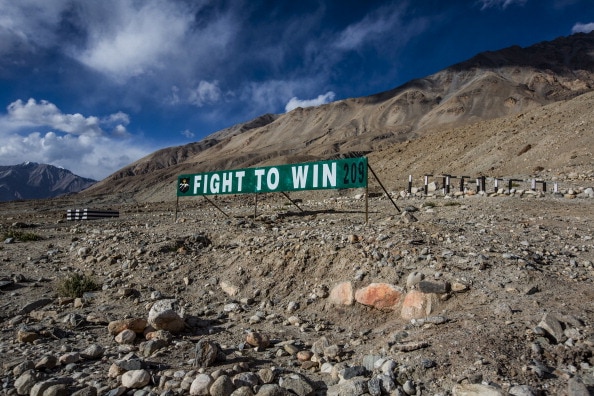Explorer
Ladakh: Why Is It The Centre Of Indo-China Tensions?
What caused Ladakh to be the hotbed of one of the worst border tensions after the Kargil conflict in 1999?

In this picture taken on May 18, 2019, road maintenance workers head back to their campsite following a day's work along Pangong Lake road near the Chang La pass in northern India's Ladakh region of Jammu and Kashmir state. (Photo by Xavier GALIANA / AFP)
New Delhi: While Congress and the ruling BJP continue to trade heated barbs over Sino-India border dispute, the tensions at the border apparently seem to have eased a bit after the military level talks between the two neighboring countries. After the reported disengagement of troops from both sides, the two parties are holding another round of Major General-level talks on Wednesday. Also Read: Ladakh Standoff: India, China Pull Back Armies At 3 Disputed Locations; Military Talks To Continue
But, does the de-escalation indicate that the boundary dispute in Ladakh is near a solution, or, is it still far from over?
Ladakh, which has been newly incorporated as a union territory of India, following the bifurcation of the erstwhile state of Jammu and Kashmir, has been the subject of dispute between India, Pakistan, and China since long.
The geographical position of the area, makes it prone to border disputes with the two troubling neighbours. It is bordered by Tibet to the east, Himachal Pradesh to the south, Jammu and Kashmir and Gilgit-Baltistan to its west, and the southwest corner of Xinjiang across the Karakoram Pass in the far north.
The trigger for the main face-off in this year was China's rigid disapproval to India laying a key road in the crucial ‘Finger area’ around the Pangong Tso Lake, most of which lies in Ladakh, apart from the construction of another road connecting the Darbuk-Shayok-Daulat Beg Oldie road in Galwan Valley. Also Check | Covid-19: Is Delhi heading towards becoming next Wuhan?
The road in the Finger area in Pangong Tso holds strategic importance for India as it is considered crucial for India to carry out patrolling activities.
 LEH, INDIA - OCTOBER 5: An Indian Military banner post is seen on the road to Pangong Lake on October 5, 2012 near to Leh, Ladakh, India. (Photo by Daniel Berehulak/Getty Images)
Due to China’s attitude, India had already decided not to stall any border infrastructure projects in eastern Ladakh.
This time, the situation in eastern Ladakh deteriorated after a violent conflict between the two troops on May 5 & May 6 along the Pangong Tso lake which led to rapid escalation in the tensions in the region. This was followed by another aggression in north Sikkim three days later.
In an article for news agency IANS explaining why a standoff happened in Ladakh, Major General (retd) S.B. Asthana, stated that China has developed its infrastructure up to LAC much earlier, but it wants to deny the same to India, which is only trying to catch up, to protect its sovereign territory.
On China’s opposition to India’s construction of roads in Pangong Tso area, he stated that China feels that this infrastructure development will make their strategic roads and positions vulnerable and put them at disadvantage.
Also Watch | LAC tension: Talks being held at Division Commander level
(based on inputs from agencies)
LEH, INDIA - OCTOBER 5: An Indian Military banner post is seen on the road to Pangong Lake on October 5, 2012 near to Leh, Ladakh, India. (Photo by Daniel Berehulak/Getty Images)
Due to China’s attitude, India had already decided not to stall any border infrastructure projects in eastern Ladakh.
This time, the situation in eastern Ladakh deteriorated after a violent conflict between the two troops on May 5 & May 6 along the Pangong Tso lake which led to rapid escalation in the tensions in the region. This was followed by another aggression in north Sikkim three days later.
In an article for news agency IANS explaining why a standoff happened in Ladakh, Major General (retd) S.B. Asthana, stated that China has developed its infrastructure up to LAC much earlier, but it wants to deny the same to India, which is only trying to catch up, to protect its sovereign territory.
On China’s opposition to India’s construction of roads in Pangong Tso area, he stated that China feels that this infrastructure development will make their strategic roads and positions vulnerable and put them at disadvantage.
Also Watch | LAC tension: Talks being held at Division Commander level
(based on inputs from agencies)
 LEH, INDIA - OCTOBER 5: An Indian Military banner post is seen on the road to Pangong Lake on October 5, 2012 near to Leh, Ladakh, India. (Photo by Daniel Berehulak/Getty Images)
Due to China’s attitude, India had already decided not to stall any border infrastructure projects in eastern Ladakh.
This time, the situation in eastern Ladakh deteriorated after a violent conflict between the two troops on May 5 & May 6 along the Pangong Tso lake which led to rapid escalation in the tensions in the region. This was followed by another aggression in north Sikkim three days later.
In an article for news agency IANS explaining why a standoff happened in Ladakh, Major General (retd) S.B. Asthana, stated that China has developed its infrastructure up to LAC much earlier, but it wants to deny the same to India, which is only trying to catch up, to protect its sovereign territory.
On China’s opposition to India’s construction of roads in Pangong Tso area, he stated that China feels that this infrastructure development will make their strategic roads and positions vulnerable and put them at disadvantage.
Also Watch | LAC tension: Talks being held at Division Commander level
(based on inputs from agencies)
LEH, INDIA - OCTOBER 5: An Indian Military banner post is seen on the road to Pangong Lake on October 5, 2012 near to Leh, Ladakh, India. (Photo by Daniel Berehulak/Getty Images)
Due to China’s attitude, India had already decided not to stall any border infrastructure projects in eastern Ladakh.
This time, the situation in eastern Ladakh deteriorated after a violent conflict between the two troops on May 5 & May 6 along the Pangong Tso lake which led to rapid escalation in the tensions in the region. This was followed by another aggression in north Sikkim three days later.
In an article for news agency IANS explaining why a standoff happened in Ladakh, Major General (retd) S.B. Asthana, stated that China has developed its infrastructure up to LAC much earlier, but it wants to deny the same to India, which is only trying to catch up, to protect its sovereign territory.
On China’s opposition to India’s construction of roads in Pangong Tso area, he stated that China feels that this infrastructure development will make their strategic roads and positions vulnerable and put them at disadvantage.
Also Watch | LAC tension: Talks being held at Division Commander level
(based on inputs from agencies)
Follow Breaking News on ABP Live for more latest stories and trending topics. Watch breaking news and top headlines online on ABP News LIVE TV
Read more
Advertisement







































